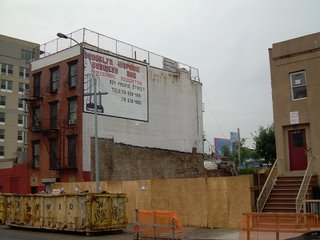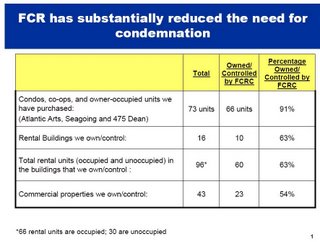Following the Empire State Development Corporation’s (ESDC) approval today of the Atlantic Yards project, tenants in two buildings owned by Forest City Ratner filed suit today in state court challenging the ESDC's use of eminent domain to demolish their buildings and override their rights as rent-stabilized tenants. The lawsuit had long been anticipated.
The lawsuit contends that a landlord that refuses to renew rent-stabilized leases and extinguish the tenants’ rights via demolition must obtain permission from the New York State Division of Housing and Community Renewal (DHCR).
 Tenants of one of the buildings, 624 Pacific Street (at left in picture), were rudely awakened in June by some startling demolitions next door. The other building is 473 Dean Street. Both would be the subject of "friendly condemnations"--actions welcomed by Forest City Ratner as owner, but not by their tenants.
Tenants of one of the buildings, 624 Pacific Street (at left in picture), were rudely awakened in June by some startling demolitions next door. The other building is 473 Dean Street. Both would be the subject of "friendly condemnations"--actions welcomed by Forest City Ratner as owner, but not by their tenants.
New legal ground
ESDC, an executive agency, cannot override DHCR’s legislative mandate, argues attorney George Locker. Still, he acknowledged that the claim raises an untested issue and would break new legal ground: “There is no reported case that I could find where the developer seeking state use of eminent domain to enable demolition was also the landlord of rent-stabilized tenants.”
Locker said that, in the past, eminent domain has been used to wipe out the leases of rent-stabilized tenants who were not tenants of buildings owned by the project developer. But he also pointed to another case, which did not involve eminent domain, “that states unequivocally that in demolition cases, DHCR was given ‘exclusive and original jurisdiction’ from the legislature.”
Private roads
In another novel claim, Locker argues that, under the New York State Constitution, a jury is required to determine the necessity of using eminent domain to seize property in order to build a private road, and the amount of compensation to be paid. (A jury has not been empaneled.)
The lawsuit cites 16 miles of private roads in the project—based on estimates from a transportation expert he consulted—mainly involving underground parking facilities.
The issue has never been tested in court, Locker said. “But the state constitutional provision requiring a jury to determine the necessity of using eminent domain to build a private road is clear, and it seems to me that this litigation will have to go up to the Court of Appeals,” he said, noting that, while some “relatively recent cases discuss juries and private roads, the issues were different” than with Atlantic Yards.
 Developer misled city?
Developer misled city?
The lawsuit argues, as Locker has done before, that in a May 26, 2005 Power Point presentation to the New York City Council, the developer "falsely represented to the members of the City Council that FCRC-owned property within the Project Site would not be subject to condemnation."
The lawsuit points to other statements about "friendly condemnations" made by ESDC Chairman Charles Gargano, noting the condemnation is not considered "friendly" by the tenants.
Settlement?
Could the suit be dropped in exchange for appropriate settlement, I asked Locker. “I am guided by my clients, who are being run over by a steamroller,” he responded. “If they are appropriately compensated, so they can permanently relocate to a comparable Brooklyn neighborhood, far from Atlantic Yards, and without threat of eviction, that is their preference.”
(He's criticized the current relocation agreements as placing the risks inappropriately on the tenants rather than the developer.)
Another case challenging the use of eminent domain, filed in federal court by property owners, a commercial tenant, and residential renters, is also pending.
The lawsuit contends that a landlord that refuses to renew rent-stabilized leases and extinguish the tenants’ rights via demolition must obtain permission from the New York State Division of Housing and Community Renewal (DHCR).
 Tenants of one of the buildings, 624 Pacific Street (at left in picture), were rudely awakened in June by some startling demolitions next door. The other building is 473 Dean Street. Both would be the subject of "friendly condemnations"--actions welcomed by Forest City Ratner as owner, but not by their tenants.
Tenants of one of the buildings, 624 Pacific Street (at left in picture), were rudely awakened in June by some startling demolitions next door. The other building is 473 Dean Street. Both would be the subject of "friendly condemnations"--actions welcomed by Forest City Ratner as owner, but not by their tenants.New legal ground
ESDC, an executive agency, cannot override DHCR’s legislative mandate, argues attorney George Locker. Still, he acknowledged that the claim raises an untested issue and would break new legal ground: “There is no reported case that I could find where the developer seeking state use of eminent domain to enable demolition was also the landlord of rent-stabilized tenants.”
Locker said that, in the past, eminent domain has been used to wipe out the leases of rent-stabilized tenants who were not tenants of buildings owned by the project developer. But he also pointed to another case, which did not involve eminent domain, “that states unequivocally that in demolition cases, DHCR was given ‘exclusive and original jurisdiction’ from the legislature.”
Private roads
In another novel claim, Locker argues that, under the New York State Constitution, a jury is required to determine the necessity of using eminent domain to seize property in order to build a private road, and the amount of compensation to be paid. (A jury has not been empaneled.)
The lawsuit cites 16 miles of private roads in the project—based on estimates from a transportation expert he consulted—mainly involving underground parking facilities.
The issue has never been tested in court, Locker said. “But the state constitutional provision requiring a jury to determine the necessity of using eminent domain to build a private road is clear, and it seems to me that this litigation will have to go up to the Court of Appeals,” he said, noting that, while some “relatively recent cases discuss juries and private roads, the issues were different” than with Atlantic Yards.
 Developer misled city?
Developer misled city?The lawsuit argues, as Locker has done before, that in a May 26, 2005 Power Point presentation to the New York City Council, the developer "falsely represented to the members of the City Council that FCRC-owned property within the Project Site would not be subject to condemnation."
The lawsuit points to other statements about "friendly condemnations" made by ESDC Chairman Charles Gargano, noting the condemnation is not considered "friendly" by the tenants.
Settlement?
Could the suit be dropped in exchange for appropriate settlement, I asked Locker. “I am guided by my clients, who are being run over by a steamroller,” he responded. “If they are appropriately compensated, so they can permanently relocate to a comparable Brooklyn neighborhood, far from Atlantic Yards, and without threat of eviction, that is their preference.”
(He's criticized the current relocation agreements as placing the risks inappropriately on the tenants rather than the developer.)
Another case challenging the use of eminent domain, filed in federal court by property owners, a commercial tenant, and residential renters, is also pending.
Comments
Post a Comment